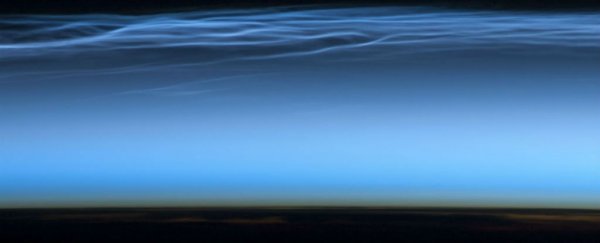Each year, an eerie mass of bright blue clouds descends over Antarctica, as sunlight is reflected though dense layers of ice crystals to create a brilliant, glowing haze that can be seen from space.
But according to new images recorded by NASA, those otherworldly clouds made their annual appearance way earlier than expected this year, and scientists are struggling to explain why we got a two-week head-start on the South Pole's 'night-shining' event.
The phenomenon that causes noctilucent - or night-shining - clouds to appear over the South Pole each year is not fully understood, but it appears to be connected to seasonal changes taking place at lower altitudes - and possibly even that catastrophic eruption of Krakatoa back in 1883.
NASA tracks the movements of noctilucent clouds using their AIM (Aeronomy of Ice in the Mesosphere) spacecraft, and while they're seen in both the southern and northern hemispheres, their electric blue glow only appears over Antarctica through the months of November and December.
Since AIM has been tracking their movements, we've seen these clouds begin their formation over the South Pole in late November or early December.
 NASA
NASA
But this year, they arrived on November 17 - the earliest noctilucent cloud start date on record, which scientists have only ever seen once before.
"This year, AIM saw the start of noctilucent cloud season on 17 November 2016 - tying with the earliest start yet in the AIM record of the Southern Hemisphere," NASA reports.
"Scientists say this corresponds to an earlier seasonal change at lower altitudes. Winter to summer changes in the Antarctic lower atmosphere sparked a complex series of responses throughout the atmosphere - one of which is an earlier noctilucent cloud season."
Noctilucent clouds are Earth's highest clouds, located 80 km above the planet's surface in an atmospheric layer called the mesosphere, which sits between the stratosphere and the thermosphere.
They're thought to be seeded by the frozen dust of disintegrating meteors, which means they're primarily made up of ice crystals. When sunlight is scattered by these crystals, it creates a brilliant blue glow above Earth that astronauts go nuts over.
"Seeing these kinds of clouds … is certainly a joy for us on the ISS," astronaut Don Pettit once remarked on NASA TV.
 Noctilucent clouds seen over Vantaa in Finland in 2009. Credit: Mika-Pekka Markkanen
Noctilucent clouds seen over Vantaa in Finland in 2009. Credit: Mika-Pekka Markkanen
One of the strangest things about these clouds is that they're a fairly new natural phenomenon, and no one's quite sure why they suddenly began their annual appearance in 1885.
Maybe it had something to do with one of the most deadly volcanic eruptions in human history?
"Noctilucent clouds are a relatively new phenomenon," Gary Thomas, a professor at the University of Colorado who studies Noctilucent clouds, told Tony Phillips at NASA.
They were first seen in 1885, Phillips reports, two years after the powerful eruption of Krakatoa in Indonesia, which deposited vast plumes of ash as high as 80 km into Earth's atmosphere - right where noctilucent clouds began to form.
The ash has since dissipated, but the clouds have remained. "It's puzzling," said Thomas. "Noctilucent clouds have not only persisted, but also spread."
At this stage, no one's sure why the South Pole's night-shining clouds appeared so early this year, or what it could signal about Earth's atmosphere.
In the past, NASA has suggested that noctilucent clouds could be the "canary in the coal mine" for methane accumulation in the atmosphere, but this has yet to be proven.
But what we do know is that these things are spreading.
"In recent years [noctilucent clouds] have intensified and spread," NASA reported back in 2013.
"When noctilucent clouds first appeared in the 19th Century, you had to travel to polar regions to see them. Since the turn of the century, however, they have been sighted as close to the equator as Colorado and Utah."
